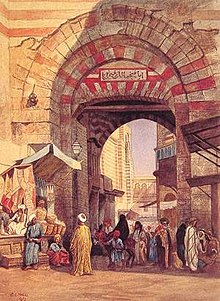


A bazaar is a permanently enclosed marketplace or street where goods and services are exchanged or sold. The term originates from the Persian word b?z?r. The term bazaar is sometimes also used to refer to the "network of merchants, bankers and craftsmen" who work in that area. Although the current meaning of the word is believed to have originated in native Zoroastrian Persia, its use has spread and now has been accepted into the vernacular in countries around the world. In Balinese, the word pasar means "market." The capital of Bali province, in Indonesia, is Denpasar, which means "north market." Souq is another word used in the Middle East for an open-air marketplace or commercial quarter.
Evidence for the existence of bazaars dates to around 3,000 BCE. Although the lack of archaeological evidence has limited detailed studies of the evolution of bazaars, indications suggest that they initially developed outside city walls where they were often associated with servicing the needs of caravanserai. As towns and cities became more populous, these bazaars moved into the city center and developed in a linear pattern along streets stretching from one city gate to another gate on the opposite side of the city. Over time, these bazaars formed a network of trading centres which allowed for the exchange of produce and information. The rise of large bazaars and stock trading centres in the Muslim world allowed the creation of new capitals and eventually new empires. New and wealthy cities such as Isfahan, Golconda, Samarkand, Cairo, Baghdad and Timbuktu were founded along trade routes and bazaars. Street markets are the European and North American equivalents.
Shopping at a bazaar or market-place remains a central feature of daily life in many Middle-Eastern and South Asian cities and towns and the bazaar remains the "beating heart" of Middle-Eastern city and South Asian life. A number of bazaar districts have been listed as World Heritage sites due to their historical and/or architectural significance. Visiting a bazaar or souq has also become a popular tourist pastime.
Contents
Etymology and usage
The origin of the word bazaar comes from Persian b?z?r. from Middle Persian w?z?r, from Old Persian v??ar, from Proto-Indo-Iranian *wah?-?arana. The term, bazaar, spread from Persia into Arabia and ultimately throughout the Middle East. Many languages have names to describe the concept of a bazaar, including Arabic and Urdu: ??????, Kurdish language has the same word bazaar meaning a marketplace. Albanian, Bosnian and Turkish: pazar, Assamese: ???? (bôzar), Bengali: ????? (ba-zar or bazzar), Odia: ????, Bulgarian and Macedonian: ?????, Cypriot Greek: pantopoula, Greek: ?????? (pazari), Hindi: ??????, Hungarian: vásár (term originates from Persian influence around the 7th–8th century and means a regular market, but special occasion markets also exist, such as Karácsonyi Vásár or "Christmas Market", and bazár or Oriental-style market or shop, the term stemming from Turkish influence around the 16th–17th century), Indonesian and Malay: pasar, Khmer:????? (phsar), Armenian: ?????, Georgian: ??????, Polish: bazar, Russian: ?????, Ukrainian: ????? and Uzbek: bozor, Uyghur: ??????, ULY: bazar, USY: ?????.
In North America, the United Kingdom and some other European countries, the term can be used as a synonym for a "rummage sale", to describe charity fundraising events held by churches or other community organisations in which either donated used goods (such as books, clothes and household items) or new and handcrafted (or home-baked) goods are sold for low prices, as at a church or other organisation's Christmas bazaar, for example. In South Korea, the word '???', composed of '??' (transliteration of 'bazaar') + ? (?, meaning 'gathering') is used to describe the sort of rummage sale described above.
Although Turkey offers many famous markets known as "bazaars" in English, the Turkish word "pazar" refers to an outdoor market held at regular intervals, not a permanent structure containing shops. English place names usually translate "çar??" (shopping district) as "bazaar" when they refer to an area with covered streets or passages. For example, the Turkish name for the Grand Bazaar in Istanbul is "Kapal?çar??" (gated shopping area), while the Spice Bazaar is the "M?s?r Çar??s?" (Egyptian shopping area). The Arabic term, souk (souq or suk) is a synonym for bazaar.
Brief history
Bazaars originated in the Middle East, probably in Persia. Pourjafara et al., point to historical records documenting the concept of a bazaar as early as 3000 BC. By the 4th century (CE), a network of bazaars had sprung up alongside ancient caravan trade routes. Bazaars were typically situated in close proximity to ruling palaces, citadels or mosques, not only because the city afforded traders some protection, but also because palaces and cities generated subtantial demand for goods and services. Bazaars located along these trade routes, formed networks, linking major cities with each other and in which goods, culture, people and information could be exchanged.
The Greek historian, Herodotus, noted that in Egypt, roles were reversed compared with other cultures and Egyptian women frequented the market and carried on trade, while the men remain at home weaving cloth. He also described The Babylonian Marriage Market.
Prior to the 10th century, bazaars were situated on the perimeter of the city or just outside the city walls. Along the major trade routes, bazaars were associated with the caravanserai. From around the 10th century, bazaars and market places were gradually integrated within the city limits. The typical bazaar was a covered area where traders could buy and sell with some protection from the elements. Over the centuries, the buildings that housed bazaars became larger and more elaborate. The Grand Bazaar in Istanbul is often cited as the world's oldest continuously-operating, purpose-built market; its construction began in 1455.
City bazaars occupied a series of alleys along the length of the city, typically stretching from one city gate to a different gate on the other side of the city. The bazaar at Tabriz, for example, stretches along 1.5 kilometres of street and is the longest vaulted bazaar in the world. Moosavi argues that the Middle-Eastern bazaar evolved in a linear pattern, whereas the market places of the West were more centralised.
In pre-Islamic Arabia, two types of bazaar existed: permanent urban markets and temporary seasonal markets. The temporary seasonal markets were held at specific times of the year and became associated with particular types of produce. Suq Hijr in Bahrain was noted for its dates while Suq 'Adan was known for its spices and perfumes. In spite of the centrality of the Middle East in the history of bazaars, relatively little is known due to the lack of archaeological evidence. However, documentary sources point to permanent marketplaces in cities from as early as 550 BCE.
Nejad has made a detailed study of early bazaars in Iran and identifies two distinct types, based on their place within the economy, namely:
- * Commercial bazaars (or retail bazaars): emerged as part of an urban economy not based on a merchant system
- * Socio-commercial bazaars: formed in economies based on a merchant system, socio-economic bazaars are situated on major trade routes and are well integrated into the city's structural and spatial systems
In the 1840s, Charles White described the Yessir Bazary of Constantinople in the following terms:
- "The interior consists of an irregular quadrangle. In the center is a detached building, the upper portion serving as a lodging for slavedealers, and underneath are cells for newly imported slaves. To this is attached a coffee-house, and near to it a half-ruined mosque. Around the three habitable sides of the court runs an open colonnade, supported by wooden columns, and approached by steps at an angle. Under the colonnade are platforms, separated from each other by low railings and benches. Upon these, dealers and customers may be seen during business hours smoking and discussing prices.
- Behind these platforms are ranges of small chambers, divided into two compartments by a trellice-work. The habitable part is raised about three feet from the ground; the remainder serves as passage and cooking place. The front portion is generally tenanted by black, and the rear by white slaves. These chambers are exclusively devoted to females. Those to the north and west are destined for second hand negresses or white women – that is, for slaves who have been previously purchased and instructed, and are sent to be resold. The hovels to the east are reserved for newly imported negresses, or black and white women of low price.
- The platforms are divided from the chambers by a narrow alley, on the wall side of which are benches, where women are exposed for sale. This alley serves as a passage of communication and walk for the brokers, who sell slaves by auction and on commission. In this case, the brokers walk around, followed by the slaves, and announce the price offered. Purchasers, seated on the platforms, then examine, question and bid, as suits their fancy, until at length the woman is sold or withdrawn."
21st century
In the Middle East, the bazaar is considered to be "the beating heart of the city and a symbol of Islamic architecture and culture of high significance." Today, bazaars are popular sites for tourists and some of these ancient bazaars have been listed as world heritage sites or national monuments on the basis of their historical, cultural or architectural value.
The Medina of Fez, Morocco, with its labyrinthine covered market streets was listed as a UNESCO World Heritage Site in 1981.[21] Al-Madina Souq is part of the ancient city of Aleppo, another UNESCO World Heritage Site since 1986.[22]The Bazaar complex at Tabriz, Iran was listed in 2010.[23] The Bazaar of Qaisiyariye in Laar, Iran is on the tentative list of UNESCO World Heritage Sites.Lar[24]
In art and literature
During the 18th and 19th centuries, Europeans conquered and excavated parts of North Africa and the Levant. These regions now make up what is called the Middle East, but in the past were known as the Orient. Europeans sharply divided peoples into two broad groups – the European West and the East or Orient; us and the other. Europeans often saw Orientals as the opposite of Western civilisation; the peoples could be threatening- they were "despotic, static and irrational whereas Europe was viewed as democratic, dynamic and rational."[25] At the same time, the Orient was seen as exotic, mysterious, a place of fables and beauty. This fascination
Watch movie Bazaar online on Amazon
Watch movie Bazaar online
Watch The Movie On PrimeA Wednesday Full HD Movie Download

Silsila Hai Pyar Ka Full HD Movie Download

Muskaan Full HD Movie Download

Nayee Padosan (2003) Full HD Movie Download
.jpg)
Paisa Vasool Full HD Movie Download

Returns Of Kaartoos Full HD Movie Download

Teen Chor Full HD Movie Download

Rajaji Full HD Movie Download

Tumaku Parunita Bhuli Full HD Movie Download

Most Wanted (Marathi) Full HD Movie Download
.jpg)
Sikaram Full HD Movie Download

My Boss Bajranbali Full HD Movie Download

Aaj Ka Hindustani Full HD Movie Download

Don Seenu Full HD Movie Download

Bharath Bandh Full HD Movie Download

Karthika Deepam Full HD Movie Download

Maha Purushudu Full HD Movie Download

Aata Modalaindi Full HD Movie Download

Ninaivil Nindraval Full HD Movie Download

Sawaal (1982) Full HD Movie Download
.jpg)
Laaga Chunari Mein Daag Full HD Movie Download

Download latest Movie from bollywood
- 1> baaghi 3
- 2> THE SKY IS PINK MOVIE FULL STORY AND REVIEW
- 3> Luka Chuppi
- 4> TO ALL THE BOYS I’VE LOVED BEFORE
- 5> Kabir Singh
- 6> Street Dancer 3D
- 7> Simmba
- 8> Gone Girl
- 9> The Girl Who Lived
- 10> Ludo
- 11> DILWALE DULHANIA LE JAYENGE
- 12> GUILTY
- 13> The Godfather
- 14> Adventures of Rusty
- 15> Sooryavanshi
- 16> Satyameva Jayate 2
- 17> Thappad
- 18> Bhool Bhulaiyaa 2
- 19> KGFChapter 2
- 20> Mardaani 2
- 21> Pinjar
- 22> Shivaji maharaj
- 23> Ek Villian 2
- 24> Hungama 2
- 25> Divergent
- 26> Mumbai Saga
- 27> The Internship
- 28> HIT (telugu)
- 29> Panga
- 30> The perfect date
- 31> 16 December
- 32> Gopala Gopala (Telugu)
- 33> Brahmastra
- 34> Gangubai Kathiawadi
- 35> Manmadhudu
- 36> Nenu local
- 37> Mahanati
- 38> Shatamanam bavathi
- 39> Lagaan
- 40> After
- 41> MOM
- 42> Shamshera
- 43> Raguvaran BTech
- 44> Khakee
- 45> The villain
- 46> OM
- 47> Mr. perfect
- 48> Bueatifull mind
- 49> Hichki
- 50> Gabbar Singh
- 51> Jogi
- 52> Before Sunrise
- 53> Before Sunset
- 54> Before Midnight
- 55> The Big Bull
- 56> Top Gun: Maverick
- 57> The Purge
- 58> The Sky is Pink
- 59> Laxmmi Bomb
- 60> Sadak 2
- 61> Sufna
- 62> Prithviraj
- 63> PK
- 64> Coolie No 1(2020)
- 65> Black Widow
- 66> Dear Zindagi
- 67> Dil Bechara
- 68> PHIR HERA PHERI
- 69> WAR
- 70> Dostana
- 71> RRR: Roudram Ranam Rudhiram
- 72> Maidan
- 73> Dabbang 3
- 74> Chhalaang
- 75> life as we know it
- 76> SherShaah
- 77> Sandeep Aur Pinky Faraar
- 78> Event Horizon
- 79> 83
- 80> Radhe: Your Most Wanted Bhai
- 81> Gunjan Saxena: The Kargil Girl
- 82> Mr India
- 83> Vivah
- 84> Anokha Bandhan
- 85> Ghost
- 86> Bhoot: Part One - The Haunted Ship
- 87> Haseen Dilruba
- 88> Laal Singh Chaddha
- 89> Qismat
- 90> Rajput
- 91> Drive
- 92> Dil Chahta Hai
- 93> Dil Ki Baazi
- 94> Dil Ka Rishta
- 95> Teesri Manzil
- 96> Dil
- 97> Love Aaj Kal
- 98> Khaali Peeli
- 99> Bunty Aur Babli 2
- 100> Atrangi Re
- 101> Gulabo Sitabo
- 102> Jodi
- 103> Suraj Pe Mangal Bhari
- 104> Deewana
- 105> Attack
- 106> Sardar Udham Singh
- 107> Toofan
- 108> THE LOVEBIRDS
- 109> Jersey
- 110> Ginny Weds Sunny
- 111> Thalaivi
- 112> Shiddat
- 113> Angels vs Zombies
- 114> Koi Mil Gya
- 115> Thank God
- 116> Bhuj: The Pride of India
- 117> Hum Aapke Hain Kaun
- 118> The Platform
- 119> Bird Box
- 120> Roohi Afzana
- 121> Torbaaz
- 122> Nikamma
- 123> World War Z
- 124> Extraction
- 125> Train to Busan
- 126> Life of Pi
- 127> SHAADI MEIN JROOR AANA
- 128> Himmat Aur Mehnat
- 129> To All The Boys: P.S. I Still Love You
- 130> Mimi
- 131> Good Newwz
- 132> Shubh Mangal Zyada Saavdhan
- 133> Raabta
- 134> Harry Potter and the Philosopher's Stone
- 135> Harry Potter and the Chamber of Secrets
- 136> Chhapaak
- 137> War of the Worlds
- 138> Harry Potter and the Prisoner of Azkaban
- 139> Harry Potter and the Goblet of Fire
- 140> MURDER MYSTERY
- 141> Shakuntala Devi
- 142> Bachchan Pandey
- 143> Jayeshbhai Jordar
- 144> Sheer Qorma
- 145> Saina
- 146> 'O' Pushpa I hate tears
- 147> Kedarnath
- 148> MS Dhoni The Untold Story
- 149> Chhichhore
- 150> Badhaai Ho
- 151> Unstoppable
- 152> Oz the Great And Powerful
- 153> The Girl on the Train
- 154> Haathi Mere Saathi 2020
- 155> The Conjuring: The Devil Made Me Do It
- 156> Gandhi Se Pehle Gandhi
- 157> The Song of Scorpions
- 158> Srimanthudu
- 159> Hello Guru Prema Kosame
- 160> Beauty and The Beast
- 161> Black Panther
- 162> Charlie and the Chocolate Factory
- 163> Bole Chudiyan
- 164> Fidaa
- 165> Duvvada Jagannadham
- 166> Bruce Lee: The Fighter
- 167> Hyper
- 168> Yaara
- 169> Red (2020)
- 170> Shivam
- 171> That Is Mahalakshmi
- 172> Nishabdham
- 173> Aashram 2020 web series
- 174> Laxmii
- 175> Mismatched
- 176> STUDENT OF THE YEAR 2
- 177> NAIL POLISH
- 178> Ramprasad Ki Tehrvi
- 179> KAAGAZ
- 180> 12 o Clock
- 181> The Power
- 182> bolo hau
- 183> Tribhanga
- 184> JAMUN
- 185> Madam Chief Minister
- 186> Maasaab
- 187> Aadhaar
- 188> Tanhaji
- 189> Bhaagi 3
- 190> Bhootnath
- 191> MALANG
- 192> Jai Mummy Di
- 193> Haathi Mere Saathi 2021
- 194> Shakeela
- 195> Unpaused
- 196> Annayya
- 197> Vamsoddharakudu
- 198> Mrugaraju
- 199> Narasimha Naidu
- 200> Sankranti
- 201> Manasu Maata Vinadhu
- 202> Anjaane
- 203> Apaharan
- 204> Bachke Rehna Re Baba
- 205> Bewafaa
- 206> Roohi
- 207> Radhe
- 208> Zindagi Khoobsoorat Hai
- 209> Yeh Mohabbat Hai
- 210> Yeh Kya Ho Raha Hai?
- 211> The Tomorrow War
- 212> DehradunDiary
- 213> Meri Shaadi Karaoo
- 214> Matruu Ki Bijlee Ka Mandola
- 215> No One Killed Jesica
- 216> Aag Ka Goola
- 217> Eight Million Dollars
- 218> Three Hundred
- 219> Cats and Dog
- 220> Decoy
- 221> Gold Rush
- 222> You Have Got Mail
- 223> Final Destination three
- 224> Tofan
- 225> Jungle
